Related Research Articles

Leiocephalidae, also known as the curlytail lizards or curly-tailed lizards, is a family of iguanian lizards restricted to the West Indies. One of the defining features of these lizards is that their tail often curls over. They were previously regarded as members of the subfamily Leiocephalinae within the family Tropiduridae. There are presently 30 known species, all in the genus Leiocephalus.

The island night lizard is a species of night lizard native to three of the Channel Islands of California: San Nicolas Island, Santa Barbara Island, and San Clemente Island. A small number of island night lizards also live on Sutil Island, near Santa Barbara Island.

Blanding's turtle is a semi-aquatic turtle of the family Emydidae. This species is native to central and eastern parts of Canada and the United States. It is considered to be an endangered species throughout much of its range. Blanding's turtle is of interest in longevity research, as it shows few or no common signs of aging and is physically active and capable of reproduction into eight or nine decades of life.

The leopard tortoise is a large and attractively marked tortoise found in the savannas of eastern and southern Africa, from Sudan to the southern Cape Province. It is the only extant member of the genus Stigmochelys, although in the past, it was commonly placed in Geochelone. This tortoise is a grazing species that favors semiarid, thorny to grassland habitats. In both very hot and very cold weather, it may dwell in abandoned fox, jackal, or aardvark burrows. The leopard tortoise does not dig other than to make nests in which to lay eggs. Given its propensity for grassland habitats, it grazes extensively upon mixed grasses. It also favors succulents and thistles.
Animal Diversity Web (ADW) is an online database that collects the natural history, classification, species characteristics, conservation biology, and distribution information on thousands of species of animals. The website includes thousands of photographs, hundreds of sound clips, and a virtual museum.
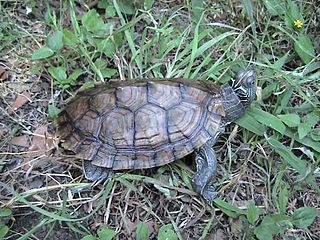
Graptemys is a genus of freshwater turtles containing 14 species, commonly known as map turtles. Graptemys are small to medium-sized turtles that are significantly sexually dimorphic, with females in some species attaining as much as twice the length and ten times the mass as males. Depending on the species, adult males range from 7–16 cm (2.75–6.25 in), adult females 10–29.5 cm (4–11.62 in), and hatchlings 2.5–3.8 cm (1–1.5 in), although some sources indicate female Barbour's map turtles grow to 33 cm (13 in) in length. Most species have a distinctive dark pigmented keel that is often notched or serrated running down the center of the carapace and serrated scutes on the rear margin. The head, neck, and limbs exhibit bold patterns of yellow lines and spots against darker green, olive, or black base colors. The patterns on the head can be important characters in identifying the various species. The common name "map turtle" is derived from the intricate patterns on their shells that are suggestive of topographical maps, although the patterns are more apparent in some species than others, and often become obscure in older specimens. Some species are occasionally called "sawbacks", in reference to the serrated keels on their shell.

The Big Bend slider, also called commonly the Mexican Plateau slider and la jicotea de la meseta mexicana in Mexican Spanish, is a species of aquatic turtle in the family Emydidae. The species is native to the Southwestern United States and northern Mexico.
Celestus fowleri, also known commonly as the bromeliad galliwasp and Fowler's galliwasp, is a species of lizard in the family Diploglossidae. The species is endemic to Jamaica.

The Rio Grande cooter is a species of turtle in the family Emydidae. The species is native to northeastern Mexico and the adjacent southwestern United States.

Morelia imbricata is a large snake found in southern regions of Western Australia and western South Australia. A member of the python family, it is commonly known as the southwestern carpet python.
Leiocephalus greenwayi, commonly known as the East Plana curlytail and the Plana Cay curlytail lizard, is a species of lizard in the family of curly-tailed lizards (Leiocephalidae). The species is native to the West Indies.
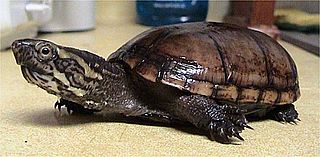
The eastern mud turtle or common mud turtle is a common species of turtle in the family Kinosternidae. The species is endemic to the United States. There are two recognized subspecies.
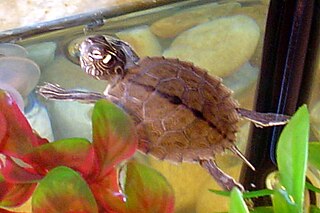
The Ouachita map turtle is a species of turtle belonging to the family Emydidae.
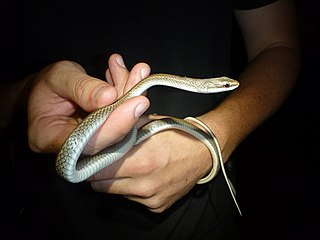
Barbour's tropical racer is a species of snake in the family Colubridae. The species is endemic to the Caribbean.
The Saint Barts blind snake is a species of blind snake in the family Typhlopidae. The species is endemic to the Caribbean island of Saint Barthélemy, an overseas collectivity of France. The species was first described in 1999, and it is still not well known.
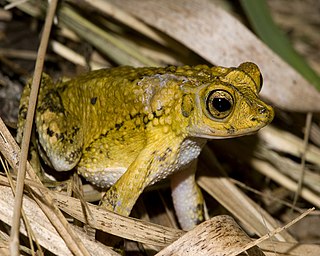
Peltophryne is a genus of true toads in the family Bufonidae, from the Greater Antilles. With ten endemic species, Cuba hosts the highest diversity. Hispaniola has three endemics and Puerto Rico and the Virgin Islands combined have one.
Eleutherodactylus michaelschmidi, the Sierra Maestra blotched frog, is a species of frog endemic to Cuba. It is also called robber frog and rain frog. It has been classified as endangered on the IUCN Global Red List and as vulnerable on the IUCN National Red List for Cuba. It was last observed in 2007.
The Marche Leon least gecko, also known commonly as the snout-shield sphaero, is a species of lizard in the family Sphaerodactylidae. The species is endemic to Haiti.
References
- ↑ "The IUCN Red List of Threatened Species". www.iucnredlist.org. Archived from the original on 2014-06-27. Retrieved 2016-02-12.
- ↑ "Caribherp". www.caribherp.org. Retrieved 2016-02-12.
- ↑ "AmphibiaWeb". amphibiaweb.org:8000/index.html. Archived from the original on 2016-10-13. Retrieved 2016-02-12.
- ↑ "The Reptile Database". www.reptile-database.org. Retrieved 2016-02-12.